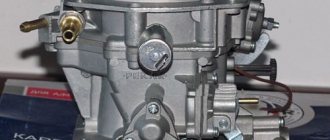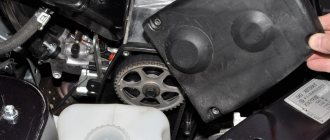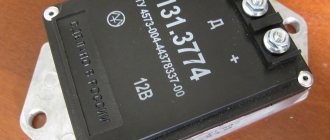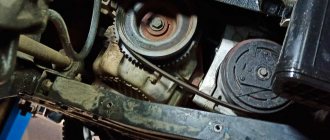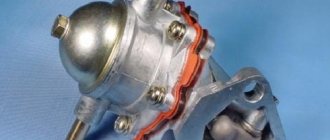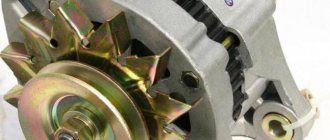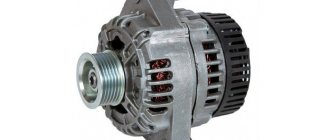The first domestic car with a belt in the gas distribution mechanism was the VAZ Five, and then all passenger cars of this plant with front-wheel drive began to be equipped with such a unit. Replacing the timing belt 2108 is much easier against a chain drive. You won’t need to look for a lift or inspection hole; if you have the appropriate skills, you won’t even need a car jack.
A similar engine is installed on the VAZ 2109, so the gas distribution mechanism on models 2108, 2109, 21081, 21083, 21093 is replaced in the same order.
Engine characteristics
Throughout the entire production period, these models were equipped with V8 power units of various modifications. They differed in their working volume, which varied by installing pistons of different diameters and a crankshaft with a reduced piston stroke. Later they began to install VAZ-2111-80 and VAZ-11183-20 engines with an injector in the power system. The first of them had a working volume of 1500 cm3, and the second was already 1600 cm3.
Replacing the timing belt on the 2108 engine, performed efficiently and in a timely manner, ensures a long period of operation of the engine. The engines are equipped with pistons with a working diameter of 76 mm; for engines with a volume of 1.5 or 1.6 liters, their diameter is increased to 82 mm, which have a recess for the valve heads. The piston stroke in the engine is 71 mm; for engines with a displacement of 1100 cm3 it was reduced to 66 mm. Replacing the timing belt on a VAZ 2108 can be done earlier than the factory recommendations if the operating rules of the power unit are not followed.
Owners of VAZ 2108, 2109 should be aware that untimely replacement of the timing belt can lead to its breakage, and this causes damage to the valves in the cylinder head of the power unit.
VAZ 21083 or VAZ 21093 engines do not have this drawback. In the event that the timing belt on these engines breaks, the valves do not meet the pistons, since the pistons have special recesses. To replace the timing belt, simply align the marks and install a new product.
Main stage
- After these steps, you can proceed to the main stage. First of all, you will need to remove the right engine mudguard. Sometimes it is enough to unscrew the two mudguard screws with a wrench to open access to the crankshaft pulley.
- The next step is to remove the alternator belt. To do this, you will need to unscrew the nut of the lower mounting bolt. Then you need to move the generator towards the engine and remove the belt itself.
- The third step is to remove the protective cover. The work is done using a key. The cover is secured with three bolts that will need to be unscrewed.
When the above work is completed, it will be possible to make a replacement. For successful work, you will need to align the installation marks of the part elements. If this is not done, all steps will have to be performed again.
As for replacing the timing belt on a VAZ-2108, it is performed as follows:
- Loosen the timing roller mounting nut using a 17 mm wrench. The loosened roller is turned counterclockwise to reduce belt tension.
- Remove the faulty timing belt. To do this, it is shifted from the pulley and removed from the tension roller.
- Install a new part purchased in advance. It is important to ensure that all the necessary marks match, otherwise the process will have to be repeated. After installation, you will need to tighten the belt with a nut.
To properly tension, you need to insert a key into the hole in the tension roller. After this you will need to turn it clockwise. The belt will begin to tighten and it is important to stop the action in time to avoid achieving too much force.
Once the belt is tightened, you will need to check its tension. If all actions are performed correctly, the part will rotate 90 degrees. Otherwise, you will have to loosen the tension until the required value is achieved.
The final steps to replace the belt will be:
- Tightening the tension roller nut.
- Reinstalling the crankshaft pulley.
- Fastening the timing cover.
- Wheel installation.
- Lowering the car from the jack.
- Battery connection.
Only after this will it be possible to start the engine to check the operation of the correct replacement. If the car starts without any problems, then the replacement was successful. If the malfunction does not disappear, it is recommended to seek help from a service station.
To change parts, it is worth considering that they have marks that need to be connected. For example, there may be no identification mark. In this case, for a high-quality connection of the parts, it will be necessary to install the gear shaft pulley in the center of the cut on the lower ebb of the cover.
To avoid frequent replacement of the timing belt in the engine, it is recommended to regularly inspect the vehicle. This way, it will be possible to identify a possible problem in advance and fix it much faster and cheaper.
VAZ 2108 is a car that has gained trust among domestic car enthusiasts. This model is equipped with an engine with a timing belt. If this part wears out, you can replace it yourself, and if necessary, seek the help of professionals at a service station.
Replacement features
The operation is not a complicated process, but requires care and concentration, since mistakes can lead to a major overhaul of the power unit. The car is placed on a level area. Wheel chocks should be installed under the wheels to prevent the machine from rolling away.
Replacing the timing belt on a VAZ 2108 engine is done as follows:
- It is necessary to remove the drive protection and the generator drive belt from the crankshaft pulley.
- You should unscrew the pulley bolt, remove it and return the bolt.
- It is necessary to remove the rubber plug from the clutch housing hatch. Next, rotate the crankshaft until the mark on the crankshaft flywheel aligns.
- The matching of the installation marks is checked.
- Loosen the tension roller fastenings and remove the timing belt in the following sequence: From the camshaft pulley.
- From the video.
- From the pump pulley.
- From the crankshaft pulley.
Note! When the timing belt is removed, do not rotate the crankshaft, because This can lead to bent valves and costly engine repairs.
Timing marks (gas distribution mechanism) of engine 21083 (2108, 21081)
The engines of VAZ 2108, 2109, 21099 cars and their modifications in the timing drive have three pairs of installation marks.
When they are combined, the camshaft and crankshaft are in a position in which the pistons of the first and fourth cylinders of the engine are at top dead center.
It is necessary to set the timing drive marks when replacing the timing belt, when setting the ignition timing, when checking and adjusting thermal valve clearances, repairing the engine and replacing its parts, etc.
Timing drive timing marks for engines 21083, 21081, 2108 of VAZ 2108, 2109, 21099 cars
Mark on the camshaft pulley and mark-protrusion on the rear timing cover
Mark on the crankshaft pulley (“sprocket”) and the ebb of the engine oil pump housing cover
A number of engines of VAZ 2108, 2109, 21099 cars have an oil pump without an installation mark on the body. In this case, when setting the timing drive marks, we focus on the marks in the clutch hatch and the camshaft pulley.
Mark on the flywheel and mark-triangular cutout of the ignition timing scale
The mark on the flywheel is a long, shallow cross mark. If there is dirt on the flywheel, it may not be visible. To detect it, you need to gradually turn the flywheel and wipe its surface with a rag soaked in solvent.
Diagram: timing marks for VAZ 2108, 2109, 21099 vehicles with engines 21083, 21081, 2108
Notes and additions
— To access the timing marks on the camshaft pulley and the rear timing cover, it is necessary to remove the outer cover of the car engine timing drive. We align the marks by rotating the crankshaft by the ratchet bolt with a “19” wrench or a large slotted screwdriver by the flywheel teeth in the clutch housing hatch clockwise. It is not recommended to turn the camshaft pulley mounting bolt with a wrench.
— To access the installation marks on the crankshaft pulley and the oil pump housing, it is necessary to jack up the car and remove the wheel from the timing drive side. Then loosen the generator, move it towards the engine (or loosen the tensioner nut, if equipped) and remove the drive belt. Next, use a key set to “19” to unscrew the crankshaft ratchet bolt (in this case, the flywheel is fixed in the clutch housing hatch by the teeth with a slotted screwdriver). We remove the generator drive pulley and screw the ratchet bolt back (you can use it to rotate the entire timing drive).
— To access the installation marks on the flywheel and the ignition timing scale on VAZ 2108, 2109, 21099 vehicles, there is a hatch in the clutch housing closed with a rubber cover. It is located under the thermostat. The flywheel in the hatch can be rotated using a large slotted screwdriver using the teeth of the flywheel crown.
Source
Belt tension
If, after turning the crankshaft, the installation marks coincide, the final tension of the timing belt is carried out. To do this, the drive uses a tension roller, which is mounted on an eccentric. You can turn it with a wrench or a special wrench, it depends on the tension mechanism. If the roller has a special nut, turn it clockwise with a wrench, then fix the nut on the roller axis. If the roller has two holes instead of a tension nut, tension is performed using a special wrench.
When such a key is missing, you can insert two bolts of suitable diameter into the holes. Next, insert a powerful screwdriver between them. By turning it clockwise, the timing mechanism drive is tightened. Correct tuning and adjustment of the timing drive is important; this will ensure achievement of the characteristics of the power unit, which are guaranteed by the engine manufacturer. If something is done incorrectly, the timing belt slides towards the engine and may break, which will lead to an emergency stop of the engine. To check the correct tension of the timing belt, turn it (twist) around its axis with two fingers, after which it should return to its original position.
Timing belts for VAZ-2108
The timing belt is a special part that makes it possible to combine the action of two shafts - the crankshaft and the camshaft. By using the part, the technical characteristics of the engine are improved, and, therefore, the quality of the car itself increases.
The standard timing belt on a VAZ-2108 with an 8-valve engine has article number K015521.
Moreover, it is equipped with a roller, through which it is possible to tension the belt and secure it in the desired position. The price for such a design ranges from 500 to 2000 rubles. The cost depends on the manufacturer and region of residence of the car owner.
The table below shows analogues of timing belts with article numbers and approximate prices. Before purchasing, you should know how many teeth there are on the belt.
| Analogue | vendor code | price, rub. |
| CONTITECH | 111Z | 300 |
| BOSCH | 1987949139 | 400 |
| GATES | K015521xs | 500 |
It is worth noting that prices are for the belt only. However, the price does not include other spare parts used to secure the part. Thus, when replacing a timing belt, you will need to increase costs and calculate possible costs in advance.
Periodicity
The vehicle operating instructions recommend replacing the timing belt on a VAZ 2109 with a mileage of 75 thousand km. Experts recommend doing this a little earlier than the period specified by the car manufacturer.
It is advisable to change the timing belt on a VAZ after a mileage of approximately 60 thousand km. Sometimes this has to be done much earlier. This may happen when engine oil gets into the drive operating area and destroys the belt structure. It is recommended to periodically inspect the transmission and the condition of the belt working area. If the slightest leaks of engine oil appear, they are repaired immediately.
Replacing the timing belt on a VAZ 2108 can be carried out earlier than the factory recommendations if the operating rules of the power unit are not followed or it is operated in difficult conditions (using the car in a taxi, traveling in sub-zero temperatures without warming up the engine).
